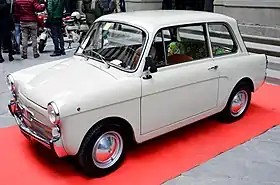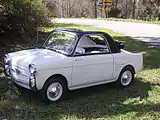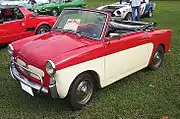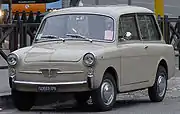Autobianchi Bianchina
The Autobianchi Bianchina is a minicar produced by the Italian automaker Autobianchi, based on the Fiat 500. It was available in various configurations: Berlina (saloon), Cabriolet (roadster), Trasformabile (fixed profile convertible), Panoramica (station wagon), and Furgoncino (van). The car was presented to the public on 16 September 1957 at the Museum of Science and Technology in Milan.
| Autobianchi Bianchina | |
|---|---|
 Autobianchi Bianchina | |
| Overview | |
| Manufacturer | Autobianchi |
| Production | 1957–1970 |
| Designer | Luigi Rapi |
| Body and chassis | |
| Class | City car |
| Body style | Berlina (saloon) Cabriolet (roadster) Trasformabile (convertible) Panoramica (station wagon) Furgoncino (van) |
| Layout | RR layout |
| Related | Fiat 500 |
| Powertrain | |
| Engine | |
| Transmission | 4-speed manual |
| Dimensions | |
| Wheelbase | 1,840 mm (72 in) (All) 1,940 mm (76 in) (Panoramica) |
| Length | 3,020 mm (119 in) (Berlina, Cabriolet) 2,985 mm (117.5 in) (Transformabile) 3,225 mm (127.0 in) (Panoramica) |
| Width | 1,340 mm (53 in) (All) |
| Height | 1,320 mm (52 in) (All) 1,330 mm (52 in) (Panoramica) |
| Curb weight | 530 kg (1,170 lb) (Berlina) 510 kg (1,120 lb) (Transformabile) 585 kg (1,290 lb) (Panoramica) 535 kg (1,179 lb) (Cabriolet) |
| Chronology | |
| Successor | Autobianchi A112 |
Initially, the car was equipped with the smallest Fiat engine, air-cooled 479 cc producing 15 PS (11 kW). In 1959, the engine power was increased to 17 PS (13 kW) and in 1960, the cabriolet version was launched.
In the same year, the Trasformabile, whose engine cylinder capacity was increased to 499 cc (18 hp), was made available in a Special version with bicolour paint and an engine enhanced to 21 PS (15 kW). This body style featured fixed B-pillar and partial roof, as the rest of the opening was covered with foldable fabric hood, whilst the Cabriolet version had no B-pillar. The Trasformabile was the only versions to feature suicide doors and in 1962, it was replaced by a four-seat saloon. The engine and chassis were the same in both.
In 1965, a minor facelift was made. In France, the models were sold under different names: the Berlina became the Lutèce, the Familiare the Texane, and the Trasformabile was marketed as the Eden Roc.[1]
Production
- Bianchina models
 Trasformabile
Trasformabile Cabriolet
Cabriolet_-_Flickr_-_mick_-_Lumix.jpg.webp) Berlina
Berlina Panoramica
Panoramica Furgoncino (low roof)
Furgoncino (low roof) Furgoncino (tall roof)
Furgoncino (tall roof)
The Bianchina was produced from 1957 to 1970, for a total volume of approximately 275,000.
| Model | Years produced | Power (bhp) | Capacity (cc) | Production |
|---|---|---|---|---|
| Trasformabile series 1 | 1957–1958 | 15 | 479 | 17,000 |
| Trasformabile series 2 | 1959–1960 | 16.5 | 479 | 10,000 |
| Trasformabile series 3 | 1961–1962 | 17.5 | 499 | 7,000 |
| Trasformabile Special | 1959–1962 | 21 | 499 | 1,500 |
| Cabriolet series 1 | 1960 | 21 | 499 | 1,050 |
| Cabriolet series 2 D | 1961–1964 | 21 | 499 | 5,500 |
| Cabriolet series 3 F | 1965–1969 | 21 | 499 | 2,750 |
| Berlina D | 1962–1964 | 17.5 | 499 | 26,500 |
| Berlina F | 1965–1969 | 18 | 499 | 33,500 |
| Berlina Special D | 1962–1964 | 21 | 499 | 4,000 |
| Berlina Special F | 1965–1969 | 21 | 499 | 5,000 |
| Panoramica D | 1960–1964 | 17.5 | 499 | 75,000 |
| Panoramica F | 1965–1969 | 17.5 | 499 | 85,000 |
| Panoramica sun roof | 1960–1969 | 17.5 | 499 | |
| Furgoncino van, low roof | 1965–1970 | 17.5 | 499 | |
| Furgonetta van, tall roof | 1970–1977 | 17.5 | 499 |
Source: Club Bianchina and Bianchina Classic Club
Autobianchi Bianchina Giardiniera
Autobianchi also used the Bianchina name for the Autobianchi Bianchina Giardiniera.[2]
In popular culture
The 1966 movie How to Steal a Million with Audrey Hepburn and Peter O'Toole features Hepburn's character driving a red Autobianchi Bianchina cabriolet.[3]
Italian comedy character Ugo Fantozzi, created by Paolo Villaggio and protagonist of television monologues, short stories and films, famously drives a white Bianchina, usually somewhat damaged and with a four-leaf clover decal on the left side. The car is known for its tendency to become badly damaged over the course of these stories.
In the animation film Despicable Me 2, the car of Lucy Wilde resembles a Bianchina Trasformabile.[4]
References
- Catalogue Salon de l'Auto 68 (in French). Paris: Europe Auto (16): 11. 1968. Missing or empty
|title=(help) - Bianchina - Giardiniera, www.autobianchi.org Retrieved on 30 July 2014
- "Autobianchi Eden Roc in "How to Steal a Million"". IMCDb.org. Retrieved 2019-09-07.
- "Autobianchi Bianchina Trasformabile in "Despicable Me 2"". IMCDb.org. Retrieved 2019-08-06.
External links
- Registro Autobianchi
- Bianchina Club at web.archive.org
- Bianchina Classic Club (Italian only)
- ( Autobianchi Bianchina Furgoncino)
| Wikimedia Commons has media related to Autobianchi Bianchina. |